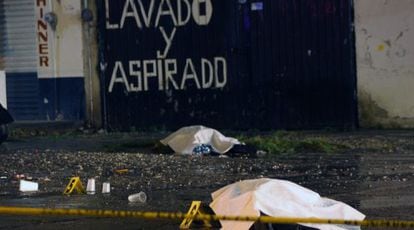Killings of students and local leaders in Guerrero intensify political violence
Shootings of politician and trainee teachers follow Mexican federal deputy’s murder


In Mexico, violence is not picky when it comes to claiming its victims. Both politicians and students have been killed by gunshots in the last few days, casting a dark shadow over the social climate and intensifying the feeling that such crimes are committed with impunity. Top leaders from the Institutional Revolutionary Party (PRI) and National Action Party (PAN) – the political groups most affected by these murders – have called for the investigations to run their course but expectations are low considering that only three percent of Mexican judicial cases result in convictions.
The most recent chapter in this tale of violence came at the weekend. With the news of the kidnapping and murder of PRI federal deputy Gabriel Gómez Michel still fresh, PAN secretary general for Guerrero, Braulio Zaragoza Maganda, was gunned down in front of his family in Acapulco, showing the long arms of organized crime leaders.
No case is solved, there is no accountability to citizens, and this brings up the question of whether we live in a state of law” PAN leader Raúl Tortolero
Around 8.30pm Sunday morning, three men barged into the restaurant at the city’s Mirador Hotel, a picturesque spot with views over the Pacific. Without hesitating, they approached the table where Zaragoza was having breakfast with his family and shot him three times in the back. He died immediately.
Some witnesses say the deputy tried to flee when he saw the hitmen. No one tried to stop them and, as is often the case, no one knows who they were. The murder shocked a country that was then still reeling from the news of the police brutality that had been committed less than 200 kilometers away in Iguala, where on Friday municipal agents had gunned down busloads of students from a teacher training school. At least two students died, another five were severely injured, and dozens more fled terrified. Their whereabouts remain unknown.
This series of violent deaths has raised the alarm in political circles. High-ranking PAN officials have said if no arrests are made in the near future, it will seem like crimes go unpunished in Mexico. Top PAN leader Gustavo Madero demanded “a swift and thorough” investigation, while the party has also asked for a special prosecutor for the Zaragoza case. Other parties have made similar demands but it remains to be seen whether this kind of pressure leads to results.
Similar calls were made after the discovery of the body of a deputy from the governing PRI a week ago, but tangible results have yet to surface – only evidence pointing to the involvement of organized crime, something that was obvious from the video of the kidnapping. At least five cars worked together to block traffic on a three-lane two-way highway before the federal deputy was pulled out of his car, without any fuss and in front of other drivers. “No case is solved, there is no accountability to citizens, and this brings up the question of whether we live in a state of law,” PAN leader Raúl Tortolero told EL PAÍS.
Witnesses say the deputy tried to flee when he saw the hitmen. No one tried to stop them and no one knows who they were
Meanwhile, some progress has been made in the Iguala case. The Prosecutor General has arrested 22 municipal agents for their part in the shooting. The level of the brutality, which has both stirred up and terrified locals, has resulted in this swift action.
The student teachers have established an independent power base in the tumultuous state of Guerrero and have a long history of clashes with security forces. But never before have these resulted in so many deaths. The first versions said dozens of students arrived in Iguala on Friday to raise funds for their activities – the so-called boteo [panhandling] – and then, at dusk, tried to take some empty buses back to their campus. They hoped to be able to use them to travel to Mexico City the following Thursday where they are planning on participating in the events to commemorate the 1968 Tlatelolco student massacre. “There was no abduction or threats; we had talked to the bus drivers and they had agreed to do us the favor of taking us to the school,” one student told local media outlets.
The police response to the seizure of the buses was savage. Officers and commandos – thought to be acting in concert – started firing at the students in various parts of the city. Most of the slaughter took place on Periférico Norte Avenue. Three buses were riddled with bullets, two people on board died and another five were severely injured. Around 50 terrified students ran off to seek refuge throughout the city.
The next morning, the body of another student teacher – flayed and with empty eye sockets – was found
The bloodshed did not end there. Around midnight, a bus carrying soccer team Avispones from Chilpancingo and two taxis were attacked under suspicion of “being armed,” the General Prosecutor’s Office said. An underage soccer player, the bus driver and a woman in one of the taxis died in the incident. To add to this violent outburst, the next morning, the body of another student teacher – flayed and with empty eye sockets – was found on Periférico Norte Avenue.
In Iguala, businesses and bars closed their doors out of fear of more killings. The city was placed under state and federal control and 300 municipal agents had their weapons seized to reestablish order. In the end, 22 officers were arrested and taken to Acapulco to prevent their colleagues and relatives from breaking them out of police custody.
Yesterday, authorities were still looking for students who had fled the attack. Hundreds of parents and classmates held a demonstration to demand that the authorities bring them back alive. Iguala Mayor José Luis Abarca said he would not resign and that he knew nothing about the massacre even though the officers operate under the command of the mayor’s office.
Translation: Dyane Jean François










































